The Biaxial Indicatrix
Steven Dutch, Professor Emeritus, Natural and Applied Sciences, Universityof Wisconsin - Green Bay
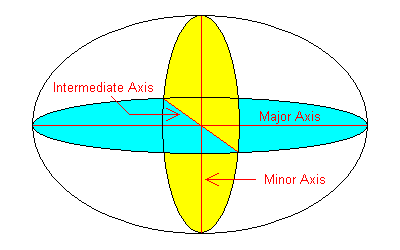 | The indicatrix is a shape called an ellipsoid. Every cross section of an ellipsoid is an ellipse. The longest direction of the ellipsoid is its major axis. The shortest direction, perpendicular to the major axis, is called the minor axis. Perpendicular to the major and minor axes is the intermediate axis. These three axes are called the principal axes. |
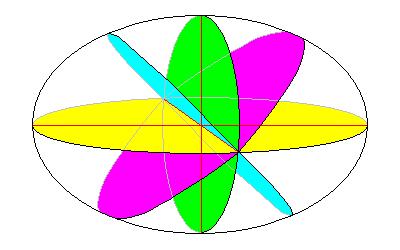 | An ellipse with three unequal principal axes has two circular cross sections. The plane containing the major and minor axis cuts the ellipsoid in an ellipse with the maximum and minimum possible radii. Somewhere in between is a radius equal to the intermediate axis. The two circular sections have radius equal to the intermediate axis and intersect along the intermediate axis. They are shown in blue and purple at left. |
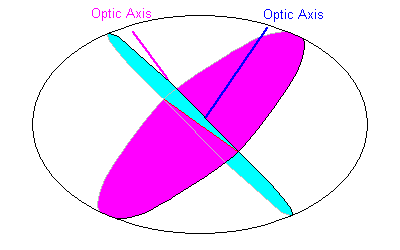 | The direction perpendicular to each circular section is the optic axis. For a generic ellipsoid with three unequal axes, there are two optic axes. Such materials are called biaxial. Biaxial minerals are orthorhombic, monoclinic or triclinic and include the pyroxenes, amphiboles, micas, feldspars, and olivine. |
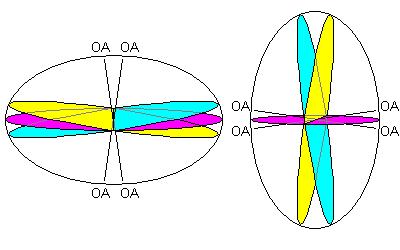 | Biaxial minerals can also be optically positive or negative. If the intermediate axis is closer to the major axis in length, the circular sections will make small angles with the major axis and the optic axes will be close to the minor axis. The indicatrix will look much like a uniaxial negative indicatrix, and the mineral is optically negative (left). If the intermediate axis is close to the minor axis in length, the circular sections will make small angles with the minor axis and the optic axes will be close to the major axis. The indicatrix will look much like a uniaxial positive indicatrix, and the mineral is optically positive (right). If the optic axes are perpendicular to each other, the mineral is on the dividing line between positive and negative. |
The most common symbols for the three refractive indices use the Greek letter alpha (α) for the smallest refractive index, beta (β)for the intermediate index and gamma (γ) for the largest.
How can you tell what the vibration directions will be for a randomly-oriented ray of light? Fortunately, there's an easy rule.
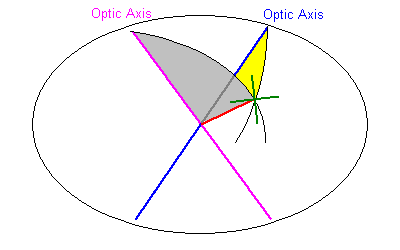 | Given a random ray direction (red):
This is the Biot-Fresnel Rule (the same Biot after whom biotite is named). |
For isotropic minerals, all rays are ordinary. For uniaxial materials, one ray is always ordinary. For biaxial minerals, both rays are usually extraordinary; neither obeys Snell's Law. The only time a ray can be ordinary is if it is vibrating in one of the circular section planes, and the only time that can happen is if the ray path is in the alpha-gamma (α-γ) plane, or perpendicular to the intermediate axis.
Return to Mineralogy-Petrology Index
Return to Thin-Section Index
Return to Crystals and Light Index
Return to Crystal Structures Index
Return to Mineral Identification Tables
Return to Professor Dutch's Home Page
Created 22 February 2005, Last Update